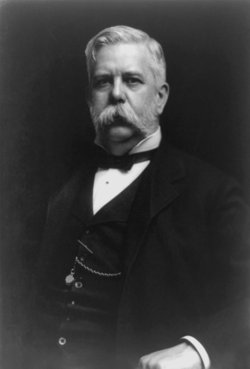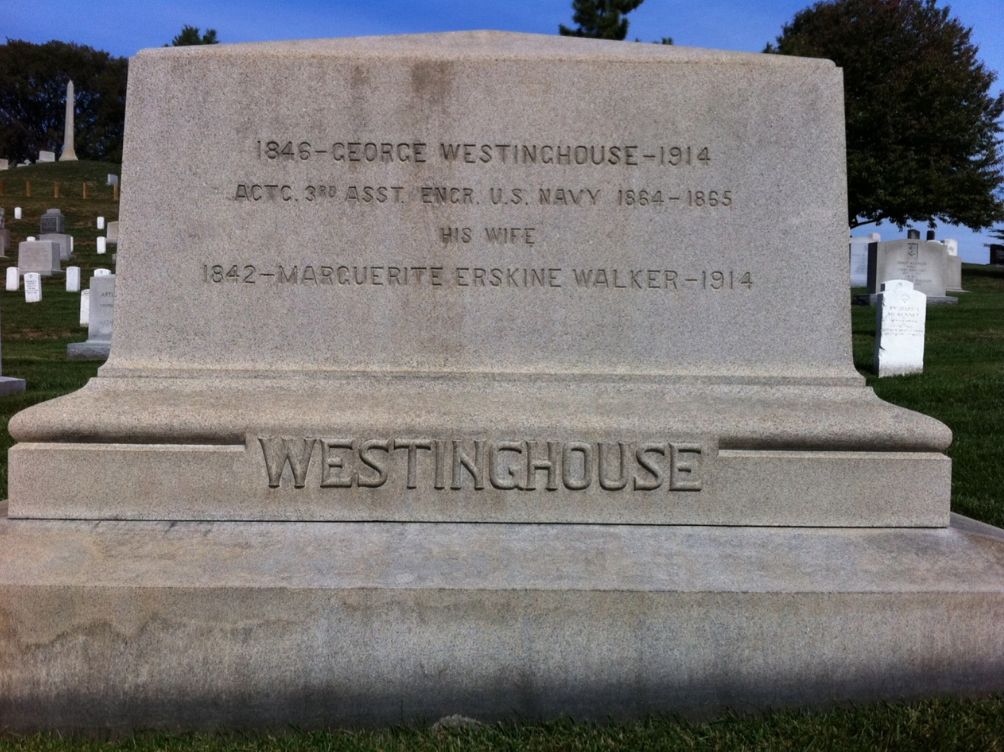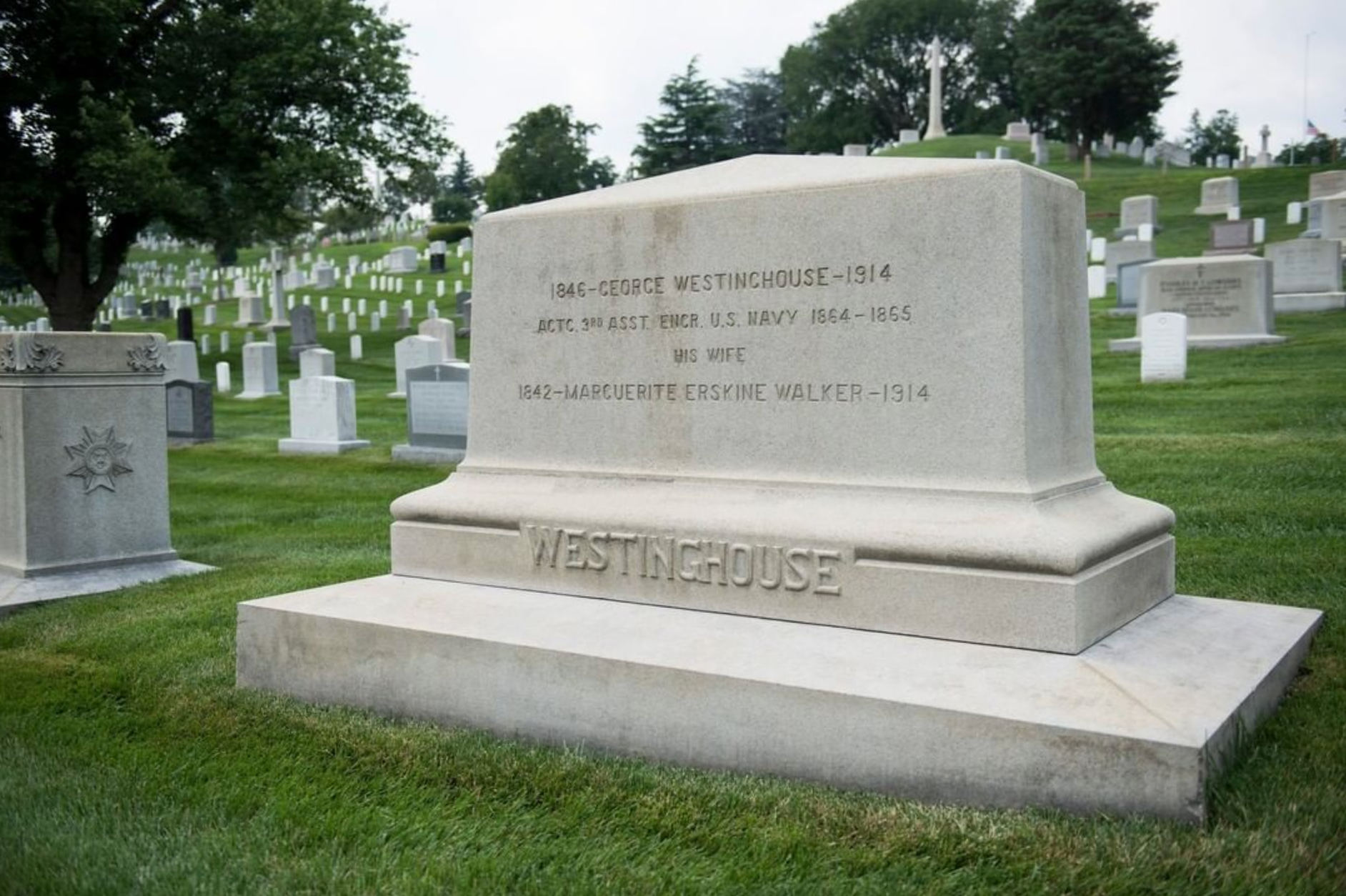He was born on October 6, 1846, in Central Bridge, New York, the son of Emeline Vedder and George Westinghouse Sr., a farm machinery manufacturer. His ancestors came from Westphalia in Germany; they first moved to England and then emigrated to the United States. The surname was Anglicized from Westinghausen. From his youth, Westinghouse was talented with machinery and business.
After several years working in his father's Schenectady shops, in 1862, the 15-year-old Westinghouse enlisted in the New York National Guard and served until his parents urged him to return home. The following year, he persuaded his parents to allow him to re-enlist, whereupon he joined Company M of the 16th New York Cavalry and earned promotion to the rank of Corporal. In December, 1864, he resigned from the Army to join the Navy, serving as Acting Third Assistant Engineer on the gunboat USS Muscoota through the end of the war.
After his military discharge in August 1865, he returned to his family in Schenectady and enrolled at Union College. He lost interest in the curriculum and dropped out in his first term.
Westinghouse was 19 years old when he created his first invention, the rotary steam engine. At age 21, he invented a "car replacer," a device to guide derailed railroad cars back onto the tracks, and a "reversible frog," a device used with a railroad switch to guide trains onto one of two tracks.
In 1867, Westinghouse met and soon married Marguerite Erskine Walker. They were married for 47 years, and had one son, George Westinghouse III, who had six children. The couple made their first home in Pittsburgh, Pennsylvania. They later acquired houses in Lenox, Massachusetts, where they summered, and in Washington, D.C.
About this time, Westinghouse witnessed a train wreck where two engineers saw one another, but were unable to stop their trains in time using the existing brakes. At that time, brakemen had to run from car to car, on catwalks atop the cars, applying the brakes manually on each car. In April of 1869, at age 22, Westinghouse obtained a patent for one of his most important inventions, the railway air brake. His railroad braking system used a compressed-air system which consisted of a compressor on the locomotive, a reservoir and a special valve on each car, and a single pipe, with flexible connections, running the length of the train. This system both refilled the reservoirs and controlled the brakes, allowing the engineers to apply and release the brakes simultaneously on all cars. This device enabled trains to be stopped with fail-safe accuracy by the engineer for the first time and was eventually adopted worldwide. It was patented by Westinghouse on October 28, 1873. The Westinghouse Air Brake Company (WABCO) was founded in Pittsburgh, Pennsylvania, to manufacture and sell Westinghouse's invention.
Westinghouse pursued many improvements in railway signals (which then used oil lamps). In 1881, he founded the Union Switch and Signal Company, based in Pittsburgh, to manufacture his signaling and switching inventions. A six-day workweek was the rule when George Westinghouse inaugurated the first Saturday half-holiday in his Pittsburgh factory in 1881.
Westinghouse saw the potential for electricity and formed the Westinghouse Electric Company in 1884. In 1885, he began experimenting with alternating current networks in Pittsburgh. In 1888, he obtained exclusive rights to Nikola Tesla's patents for a polyphase system of alternating current, which is still the basis of all modern electric power generation and distribution, persuading the inventor to join the Westinghouse Electric Company as Chief Engineer. Fears about its safety and reliability engendered public opposition to the development of alternating current electricity. Undeterred, Westinghouse proved all his critics wrong, including direct current die-hard Thomas Alva Edison.
In 1893, Westinghouse won the bid to design and light the entire 1893 World's Columbian Exposition in Chicago with alternating current, slightly underbidding Edison's General Electric to get the contract. The Exposition also devoted a building to electrical exhibits. This success led to a contract to build 3 huge hydroelectric generators for harnessing the energy of Niagara Falls. Installation on this project began in April of 1895, and, by November of 1895, all 3 generators were completed. A year later, engineers in Buffalo, New York, closed the circuits that completed the process of bringing power from Niagara Falls.
Westinghouse remained productive and inventive almost his entire life. At one time, Westinghouse began to work on heat pumps that could provide heating and cooling. At the turn of the century, he controlled 15 companies worth about $120 million, employing approximately 50,000 workers, but this was not to last.
Westinghouse remained a captain of American industry until 1907, when the Financial Panic of 1907 led to his resignation from control of the Westinghouse Company. By 1911, he was no longer active in business and his health was in decline. The financial collapse of Westinghouse's empire was one of the more notable fallouts of the Panic of 1907 and caused him to lose control of the companies he had founded. Spending much of his later life in public service, Westinghouse showed signs of a heart ailment by 1913 and was ordered to rest by doctors. After deteriorating health and illness confined him to a wheelchair, he died on March 12, 1914, in New York City at age 67.
He was initially interred in Woodlawn Cemetery, Bronx, New York, then removed on December 14, 1915. As a Civil War veteran, he was buried in Arlington National Cemetery, along with his wife Marguerite, who survived him by three months.
With a total of 361 patents to his credit, his last patent was granted in 1918, four years after his death.
In 1918, his former Pittsburgh home, Solitude, was razed and the land given to the City of Pittsburgh to establish Westinghouse Park. In 1930, the Westinghouse Memorial, funded by his employees, was placed in Schenley Park in Pittsburgh. Also named in his honor, the George Westinghouse Bridge is near the site of his Turtle Creek plant in the Pittsburgh area. The George Westinghouse Jr. Birthplace and Boyhood Home in Central Bridge, New York, was listed on the National Register of Historic Places in 1986. In 1989, Westinghouse was inducted into the National Inventors Hall of Fame.
He was born on October 6, 1846, in Central Bridge, New York, the son of Emeline Vedder and George Westinghouse Sr., a farm machinery manufacturer. His ancestors came from Westphalia in Germany; they first moved to England and then emigrated to the United States. The surname was Anglicized from Westinghausen. From his youth, Westinghouse was talented with machinery and business.
After several years working in his father's Schenectady shops, in 1862, the 15-year-old Westinghouse enlisted in the New York National Guard and served until his parents urged him to return home. The following year, he persuaded his parents to allow him to re-enlist, whereupon he joined Company M of the 16th New York Cavalry and earned promotion to the rank of Corporal. In December, 1864, he resigned from the Army to join the Navy, serving as Acting Third Assistant Engineer on the gunboat USS Muscoota through the end of the war.
After his military discharge in August 1865, he returned to his family in Schenectady and enrolled at Union College. He lost interest in the curriculum and dropped out in his first term.
Westinghouse was 19 years old when he created his first invention, the rotary steam engine. At age 21, he invented a "car replacer," a device to guide derailed railroad cars back onto the tracks, and a "reversible frog," a device used with a railroad switch to guide trains onto one of two tracks.
In 1867, Westinghouse met and soon married Marguerite Erskine Walker. They were married for 47 years, and had one son, George Westinghouse III, who had six children. The couple made their first home in Pittsburgh, Pennsylvania. They later acquired houses in Lenox, Massachusetts, where they summered, and in Washington, D.C.
About this time, Westinghouse witnessed a train wreck where two engineers saw one another, but were unable to stop their trains in time using the existing brakes. At that time, brakemen had to run from car to car, on catwalks atop the cars, applying the brakes manually on each car. In April of 1869, at age 22, Westinghouse obtained a patent for one of his most important inventions, the railway air brake. His railroad braking system used a compressed-air system which consisted of a compressor on the locomotive, a reservoir and a special valve on each car, and a single pipe, with flexible connections, running the length of the train. This system both refilled the reservoirs and controlled the brakes, allowing the engineers to apply and release the brakes simultaneously on all cars. This device enabled trains to be stopped with fail-safe accuracy by the engineer for the first time and was eventually adopted worldwide. It was patented by Westinghouse on October 28, 1873. The Westinghouse Air Brake Company (WABCO) was founded in Pittsburgh, Pennsylvania, to manufacture and sell Westinghouse's invention.
Westinghouse pursued many improvements in railway signals (which then used oil lamps). In 1881, he founded the Union Switch and Signal Company, based in Pittsburgh, to manufacture his signaling and switching inventions. A six-day workweek was the rule when George Westinghouse inaugurated the first Saturday half-holiday in his Pittsburgh factory in 1881.
Westinghouse saw the potential for electricity and formed the Westinghouse Electric Company in 1884. In 1885, he began experimenting with alternating current networks in Pittsburgh. In 1888, he obtained exclusive rights to Nikola Tesla's patents for a polyphase system of alternating current, which is still the basis of all modern electric power generation and distribution, persuading the inventor to join the Westinghouse Electric Company as Chief Engineer. Fears about its safety and reliability engendered public opposition to the development of alternating current electricity. Undeterred, Westinghouse proved all his critics wrong, including direct current die-hard Thomas Alva Edison.
In 1893, Westinghouse won the bid to design and light the entire 1893 World's Columbian Exposition in Chicago with alternating current, slightly underbidding Edison's General Electric to get the contract. The Exposition also devoted a building to electrical exhibits. This success led to a contract to build 3 huge hydroelectric generators for harnessing the energy of Niagara Falls. Installation on this project began in April of 1895, and, by November of 1895, all 3 generators were completed. A year later, engineers in Buffalo, New York, closed the circuits that completed the process of bringing power from Niagara Falls.
Westinghouse remained productive and inventive almost his entire life. At one time, Westinghouse began to work on heat pumps that could provide heating and cooling. At the turn of the century, he controlled 15 companies worth about $120 million, employing approximately 50,000 workers, but this was not to last.
Westinghouse remained a captain of American industry until 1907, when the Financial Panic of 1907 led to his resignation from control of the Westinghouse Company. By 1911, he was no longer active in business and his health was in decline. The financial collapse of Westinghouse's empire was one of the more notable fallouts of the Panic of 1907 and caused him to lose control of the companies he had founded. Spending much of his later life in public service, Westinghouse showed signs of a heart ailment by 1913 and was ordered to rest by doctors. After deteriorating health and illness confined him to a wheelchair, he died on March 12, 1914, in New York City at age 67.
He was initially interred in Woodlawn Cemetery, Bronx, New York, then removed on December 14, 1915. As a Civil War veteran, he was buried in Arlington National Cemetery, along with his wife Marguerite, who survived him by three months.
With a total of 361 patents to his credit, his last patent was granted in 1918, four years after his death.
In 1918, his former Pittsburgh home, Solitude, was razed and the land given to the City of Pittsburgh to establish Westinghouse Park. In 1930, the Westinghouse Memorial, funded by his employees, was placed in Schenley Park in Pittsburgh. Also named in his honor, the George Westinghouse Bridge is near the site of his Turtle Creek plant in the Pittsburgh area. The George Westinghouse Jr. Birthplace and Boyhood Home in Central Bridge, New York, was listed on the National Register of Historic Places in 1986. In 1989, Westinghouse was inducted into the National Inventors Hall of Fame.
Bio by: Angela
Inscription
ACTC. 3RD ASST. ENCR. U.S. NAVY 1864-1865
HIS WIFE
Family Members
Advertisement
See more Westinghouse memorials in:
Records on Ancestry
Advertisement

















